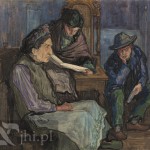Last week I wrote a blog entry about two books – Rutu Modan’s The Property and Louise Steinman’s The Crooked Mirror. Today Louise Steinman has written a blog post on her site about the book tour she’s presently on to share The Crooked Mirror story with others. She has very kindly included the Moshe Rynecki project in her blog post along with two of my great-grandfather’s paintings. You can visit her site and read about her travels in: On the Road with “The Crooked Mirror”.
Here’s a link to my book review of The Crooked Mirror and The Property that I wrote last week.









